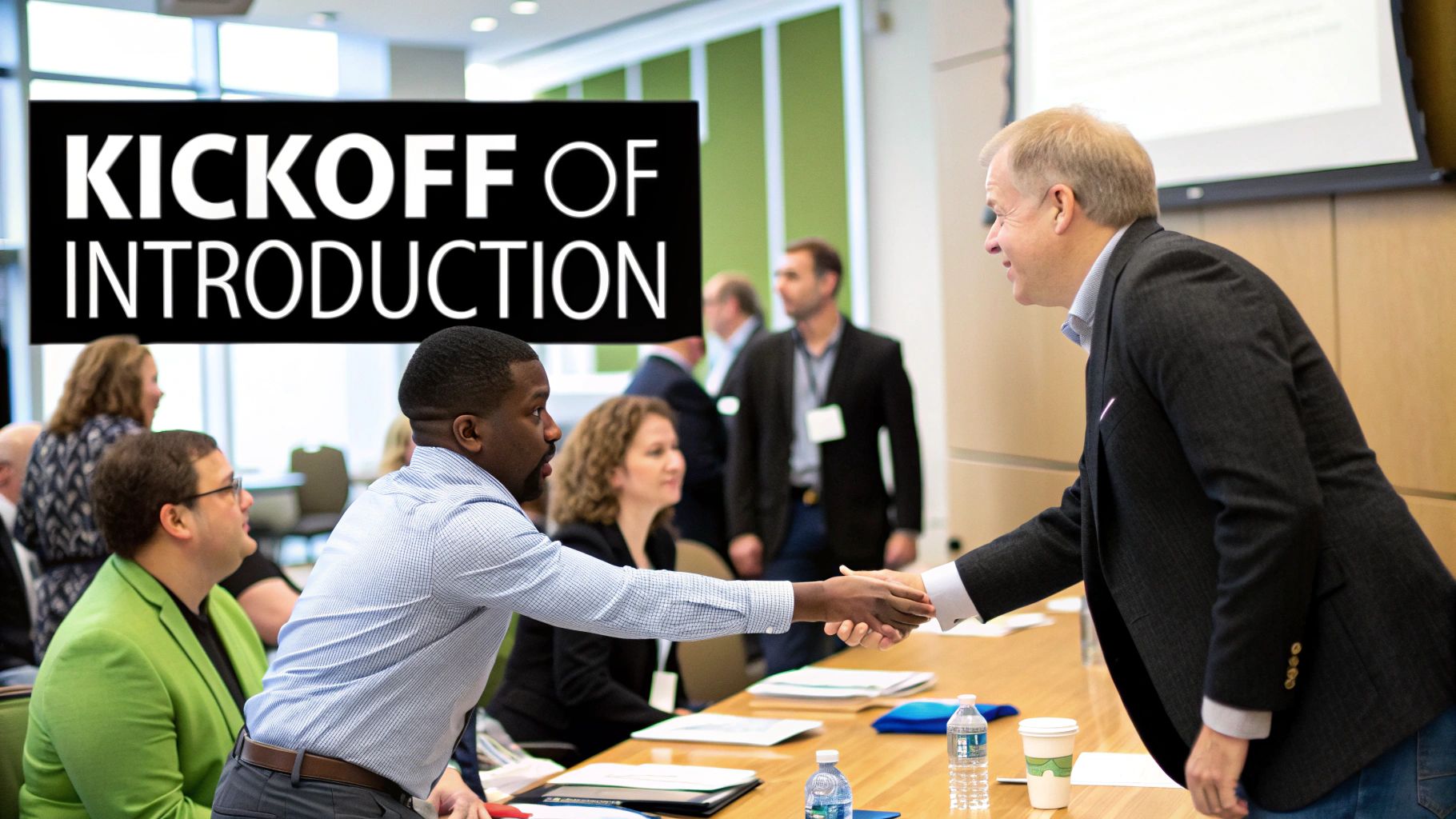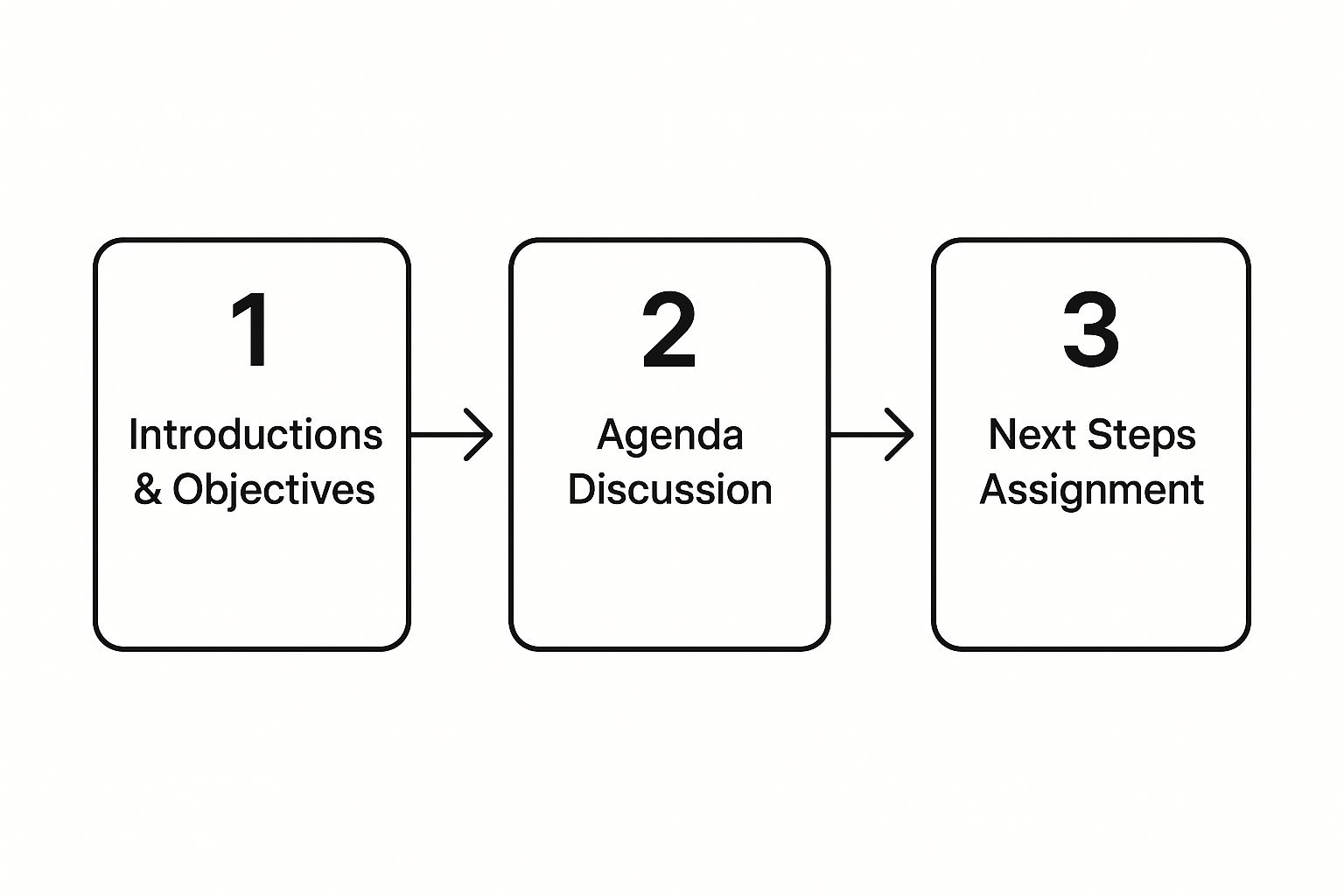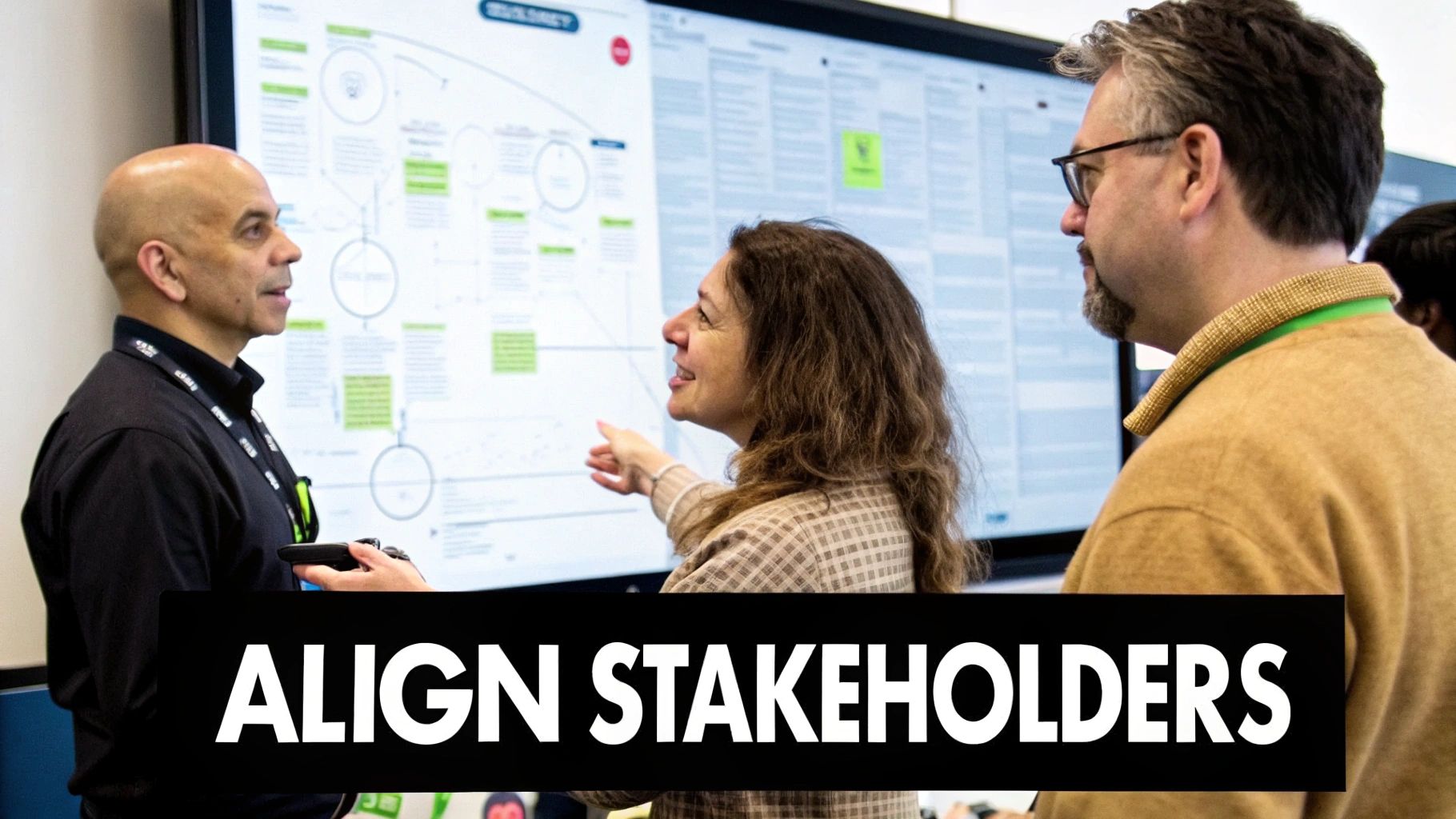A project kickoff meeting agenda isn't just a document; it's your secret weapon. It transforms what could be a routine meeting into a powerful session that gets everyone aligned and excited. Think of it as a detailed roadmap that guides the conversation around goals, scope, roles, and timelines, making sure every single person starts on the same page.
Why a Great Kickoff Is Your Project's First Win

Let’s be real—a project kickoff is much more than a calendar invite. It’s your first, and best, shot at preventing the kind of confusion that sends projects spiraling down the road. A well-run kickoff meeting isn't just about ticking a box; it's about building real momentum and securing genuine buy-in from day one.
This first meeting really does set the tone for everything that follows. When you get it right, you establish clear expectations and create a foundation for accountability. It's the moment you stop talking about abstract ideas and start making concrete plans.
Aligning Everyone From the Start
The number one job of a kickoff is to get everyone aligned. That means everyone—from the project sponsor down to the newest designer—needs to hear the exact same message about the project's purpose, what success looks like, and the key objectives we're aiming for. Without that shared understanding, people start making their own assumptions, which almost always leads to wasted time and frustrating rework.
This is especially true for complex projects. Take the construction industry, for example. Kickoff meetings are the bedrock of their process, bringing contractors, architects, and clients into alignment before a single brick is laid. When those meetings are led well, they dramatically boost efficiency by setting up strong communication channels right from the start.
From Agenda to Action
A killer agenda does more than just list topics to discuss. It tells the story of the project: why it matters, what you're all going to build together, and how you'll get there. This is your chance to establish the ground rules for how you'll operate as a team.
A project kickoff isn’t just about what you’ll do; it’s about how you’ll work together. This is your chance to build a culture of open communication and mutual respect that will carry you through challenges.
Clarifying these rules is crucial for a smooth ride. A huge part of this is figuring out how the team will communicate, which is why putting together a solid https://creativize.net/blog/project-communication-plan-template is the perfect follow-up to your kickoff.
And if you want to dig even deeper, there are some great strategies out there for mastering the art of effective kickoff meetings.
Building Your Agenda's Essential Framework
A great project kickoff meeting agenda is more than a to-do list; it’s your roadmap to getting everyone on the same page and moving in the right direction. Forget those generic templates. Let's talk about the non-negotiable building blocks that will actually give your meeting purpose and prevent confusion down the road.
This is the basic flow I've seen work time and time again, broken down into three simple phases.

It’s a natural progression. You start with the big picture, get into the nitty-gritty details, and end with everyone knowing exactly what they’re responsible for. Simple, but incredibly effective.
Before we dive deep into crafting each section, here’s a quick overview of what a solid agenda needs.
Essential Kickoff Agenda Components at a Glance
This table breaks down the key sections you'll want to include and why each one matters. Think of it as your cheat sheet for building an agenda that covers all the critical bases.
| Agenda Section | Primary Objective | Key Questions to Answer |
|---|---|---|
| Project Background & Purpose | Establish context and shared understanding of the "why." | Why are we doing this? What problem are we solving? |
| Scope & Deliverables | Define clear boundaries to prevent scope creep. | What exactly are we building? What is not included? |
| Roles & Responsibilities | Clarify who owns what to ensure accountability. | Who is the key decision-maker? Who is responsible for each task? |
| Timeline & Milestones | Set realistic expectations for pacing and key dates. | What are the major phases? When are they due? |
| Risks & Obstacles | Proactively identify potential roadblocks. | What could go wrong? How will we handle it? |
| Communication Plan | Agree on how the team will stay in sync. | How often will we meet? What tools will we use? |
| Q&A / Next Steps | Solidify understanding and define immediate actions. | What questions do you have? What's the very next step? |
Having these components in place turns a potentially chaotic meeting into a focused, productive session where real alignment happens.
Framing the Project Background and Purpose
Every project has an origin story. Don't just jump into the tasks; start with the why. Was this sparked by a direct client request? A need to bump up a key business metric? A strategic move into a new market? Giving this context right away is crucial for getting true buy-in.
Then, immediately follow up with a purpose statement that’s sharp and clear. What will this project actually accomplish? This isn't a long list of features. It’s a tight summary of the desired outcome. Something like, "We are redesigning our checkout flow to cut cart abandonment by 15% before the end of Q3."
Your project’s purpose statement should be specific, measurable, and easy for everyone in the room to grasp, from the newest developer to the CEO. It’s the north star for every decision that follows.
Defining Scope and Key Deliverables
This is your moment to stop scope creep before it even thinks about starting. You need to be brutally clear about what is in scope—the specific tasks, features, and results the team is signing up for. And just as important, be explicit about what is out of scope.
For example, if you're launching a new mobile app, the scope might cover user login and a main dashboard. Out of scope? Maybe the web-based version or future admin tools are slated for a later phase. Listing both leaves no room for assumptions and protects your schedule from day one.
- In Scope Example: Building a five-page informational website with a standard contact form.
- Out of Scope Example: Adding e-commerce features or a blog to the initial launch.
Getting this granular is a core part of building a manageable and successful creative project workflow. It ensures every person knows the exact fences around their work.
Finally, lay out the key milestones and a realistic timeline. This doesn’t have to be a super-detailed, minute-by-minute project plan. Just highlight the major phases and their target completion dates. It gives stakeholders the visibility they need and helps the team get a feel for the project’s rhythm right from the start.
Look, a one-size-fits-all agenda for a project kickoff is a surefire way to host a meeting that feels completely pointless. You simply can't treat every project the same.
The real skill is knowing how to take a solid framework and bend it to fit the situation. A quick-and-dirty internal marketing campaign just doesn’t need the same obsessive, granular detail as a year-long software build for a massive client.
So, where do you start? Think about the fundamental methodology driving your project. Is it a classic Waterfall approach, where every single detail has to be nailed down before anyone writes a line of code? If that’s the case, your agenda needs to be heavy on things like detailed scope documents, risk registers, and a timeline that’s set in stone. The entire point of that meeting is to walk away with zero confusion about what’s being built.
Client-Facing vs. Internal Meetings
The audience changes everything, too. A kickoff with a new client is part project management, part sales pitch. You're there to build confidence. Your agenda should be structured to show off your team's expertise, prove you understand their business goals, and lay out crystal-clear communication channels. You'll naturally spend more time on the "why" and the background of the project.
An internal kickoff, on the other hand, can be much more direct. Everyone in the room already gets the company context, so you can jump right into the meat of it—roles, potential technical roadblocks, and the nitty-gritty of the workflow. These meetings are often way more collaborative and are a great spot for some creative brainstorming. If you want to see what a really collaborative session looks like, check out our guide for a design thinking workshop agenda.
Agile vs. Waterfall Kickoffs
An Agile project? That's a whole different beast, and it demands a different mindset for your kickoff.
It’s no surprise that 71% of companies are now using Agile methods. These projects are 1.5 times more successful than old-school ones, and that success comes from embracing change, not fighting it.
For an Agile kickoff, you’ll be focusing less on rigid plans and more on:
- The Vision: Getting everyone fired up about the high-level goal and the value you’re creating for users.
- The Team: Agreeing on how you’ll work together, communicate, and make decisions as a self-organizing unit.
- The First Sprint: Defining a clear, achievable goal for the very first cycle of work.
The agenda here isn't about locking everything down. It's about empowering the team with a clear direction and the freedom to figure things out as they go.
The best kickoff meeting agenda isn’t some form you just fill out. It's a strategic tool you have to thoughtfully shape based on your project's complexity, its methodology, and who's in the room. Getting that right is what turns a kickoff from a formality into a launchpad.
Leading a Kickoff That People Actually Enjoy

A killer project kickoff meeting agenda template is half the battle, but your skills as a facilitator are what really bring it to life. Let's be honest, the goal isn't just to plow through a list of topics. It's about generating real energy, getting everyone on the same page, and making people genuinely excited to dive in.
You're the one setting the tone from the very first minute. So, start with enthusiasm and make the purpose crystal clear. Don't just read from your slides—frame the meeting as a proper collaborative session. Think of yourself less as a lecturer and more as a guide for the conversation.
Driving Active Participation
Your mission is to encourage active participation, not passive listening. It’s a game-changer.
A simple trick is to call on people by name (in a friendly way, of course!) for their input, especially when you know they have specific expertise on a topic. Instead of asking a closed question like, "Does this timeline work for everyone?", try an open-ended one: "What potential challenges do you all see with this timeline?"
Getting everyone to contribute is critical for sniffing out risks and aligning on how you'll communicate. This meeting is where you build a common language for the project. When everyone adds their two cents, you close perception gaps and nail down communication protocols right from the start. Trust me, this simple act prevents a world of costly headaches down the road.
The best facilitators are like skilled hosts at a dinner party. They make sure everyone feels included, keep the conversation flowing, and know how to gently steer things back on track if they go astray.
Handling Tough Questions and Disagreements
Tough questions and disagreements aren't a sign of failure; they're a sign that people are engaged. When someone raises a valid concern, thank them for it. This simple acknowledgment shows you value their perspective and makes it safe for others to speak up, too.
What if a discussion gets too deep or veers off-topic? Use a "parking lot." Acknowledge the point, jot it down on a whiteboard or in a shared doc, and promise to tackle it after the meeting or with a smaller group. This respects the comment without derailing your entire agenda.
Facilitating well helps you get ahead of a ton of potential issues. Scope creep is a classic example. For more on that, check out our guide on how to manage scope creep before it ever becomes a problem for your project.
Get Your Free Kickoff Agenda Template
All this theory is great, but let's be honest—nothing beats a practical tool you can grab and use right away. We've been there. That’s why we pulled together all the best practices from this guide into a clean, effective project kickoff meeting agenda template. Think of it as your new starting point for any project.
This isn't just some blank document, either. We’ve baked in helpful comments to walk you through how to customize each section. It’s built to be flexible, whether you're kicking off a simple internal task or a major client-facing initiative.
Here’s a little peek at the clean structure you'll be working with.
See how it lays everything out? We designed it with distinct sections for every key topic. It’s all about making sure nothing critical falls through the cracks when you're the one leading the meeting.
Click here to download your free Project Kickoff Agenda Template and get a serious head start on planning your next project launch.
So, What Questions Can You Expect?

Even with the slickest project kickoff meeting agenda template, you’re going to get questions. It’s a good thing! It means people are engaged. Answering these common queries right away gets everyone on the same page and feeling good about the path forward.
From my experience, a few questions pop up nearly every time. Let’s walk through them.
The big one is always about the guest list. "Who really needs to be here?" The trick is to keep it lean. Think of this as your mission control—only the essential crew gets a seat.
That core group should include:
- The Project Team: These are the folks in the trenches, doing the day-to-day work.
- Key Stakeholders: Your project sponsor, the department head footing the bill, or anyone with final veto power.
- Client Reps: If it's an external project, your main client contact is a must-have. No exceptions.
Fight the urge to invite the entire company. A packed room just leads to side conversations and slow decisions. You want the key decision-makers and the doers all in one place, guaranteeing you’re all starting from the same spot.
How Long Should This Meeting Be?
The next hot topic is always about time. How long is this thing going to take? While it totally depends on how complex the project is, the sweet spot is usually 60 to 90 minutes.
That's typically enough time to get through everything without people secretly checking their email under the table. A simple internal project? You might knock it out in 45 minutes. A massive, multi-department beast? That could push two hours, but be careful.
The most important thing here is respecting everyone's time. Send the agenda ahead of schedule and stick to it. It shows you’re organized and that you value their input.
If a topic starts a debate that threatens to blow up your schedule, call an audible. Use the "parking lot" method. Acknowledge it’s a great point, jot it down on the side, and promise to schedule a separate, smaller meeting to hash it out.
What Happens After We All Leave?
The meeting ending doesn't mean the work is over. Actually, what you do right after is just as important for keeping the energy up. The project manager needs to send a recap email within 24 hours.
This isn't just a courtesy email. It's a critical piece of the project puzzle.
Your follow-up absolutely has to include:
- A quick summary of the big decisions and the meeting minutes.
- A crystal-clear list of action items, assigned to specific people with due dates.
- Links to your presentation slides and any other documents you shared.
This email holds everyone accountable and serves as the official record of what was agreed upon. It’s your first real step in tracking progress and making sure the project doesn't stall out before it even begins. Getting this alignment right from the start is also foundational to how you’ll eventually measure project success, because it sets the baseline for everything that follows.
At Creativize, we connect businesses with the creative talent they need to bring their projects to life. Find the perfect designer, animator, or branding expert for your next big idea. Discover top-tier local talent on Creativize.

